 |
||
|
||
| ||
 NLE (Non linear editing) systems and video processing technologies based on personal computers have been developing for more than 10 years already. The NLE has some advantages over a traditional linear editing: a possibility to instantly instantly any fragment, lack of quality degradation after copying and boundless editing capabilities. Conversion of an analog television signal into a digital form forms a data stream from 202 to 540 Mbit/s (25-67 MBytes/s). Operations of recording and reproduction of such huge volumes on a PC are still connected with big problems. Even for the latest drives it is difficult to provide such a stream, and several years ago when the NLE systems were making their first steps the fastest SCSI drives provided just 3-5 MBytes/s. Linear read speed of some modern hard drives
One more problem is a narrow bandwidth of the internal interface bus. For example, the most widespread 32bit PCI bus provides a peak stream a maximum of 132 MBytes/s, but a real data rate taking into account several more devices on the bus is much lower. Therefore, till recently there were only two ways to create a PC based digital video system. The first way was to use modular soft hardware systems (a video editing block is an external device) where a computer had only management functions. The second way was to use desktop systems which actively used computer resources and worked with a compressed video signal on all processing stages. Compression reduces requirements for a computer platform, and first of all, to a disc subsystem, that is why the boards which use one or another compression algorithm are so popular. In most cases a small degree of compression is necessary as it provides high quality with a considerable reduction of a data flow. The first type of compression was intraframe Motion JPEG which provided broadcast quality of a signal with the compression degree equal to 3:1. MPEG makes possible to eliminate both spatial and time redundancy at 10:1 to 50:1 compression. But if it is necessary to carry out complicated multilayer editing the compression is not desired as calculation of each frame involves a multiple compression/decompression cycle which causes considerable artifacts. Modular systems working with uncompressed video lack for such drawbacks, but they have some other disadvantages apart from a high price. For example, the number of functions is great but limited, and any modification needs significant expenses and often causes technical difficulties. A closed cycle doesn't make possible to use intermediate results, export and import media data and organize video production in a local work group. It is a significant limitation for today as it is often required to separate the work of a complicated project. Disadvantages of the modular systems are obvious but till recently there was no any alternatives for operation with a uncompressed signal especially in a real-time mode. But rapid development of data storage technologies and an overall performance increase of PCs made possible to create desktop systems for video processing which are very close to expensive modular systems in capabilities. At the same time, their price is rather low, and now the cost/capabilities ratio becomes more optimal for flexible and multifunctional desktop systems. Computer systems of video processing are developing according to the laws peculiar to the whole high-tech sphere of computer engineering. There is a transition from single-purpose systems of hundreds of thousands dollars to desktop PCs which can implement the same functions. Functions of separate hardware modules are also currently transferred to the central processor. Some day CPUs will become so powerful that they will be able to process uncompressed video in a real-time mode. At present additional instruction sets such as MMX, SSE, SSE2 and 3DNow! are the first steps towards it. 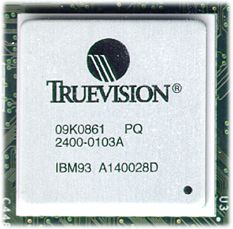 Today the major video load falls on special processors capable to process quickly huge arrays of graphics data. For a long time the same chips were used both in modular editing stations and in desktop systems. However, today there are high-performance video processors meant for desktop systems. For example, HUB3 chip from Truevision. Before I turn to examination of this multifunctional processor I'd like to describe general principles of development of computer systems of video editing. The most of modern digital cards for nonlinear editing took their data flow architecture from the systems working with an analog signal. In this case all video and audio streams pass a row of real-time processors and get mixed in the output mixer. A sequence of processing is established at the designing stage and no changes are possible without changing the card's design. 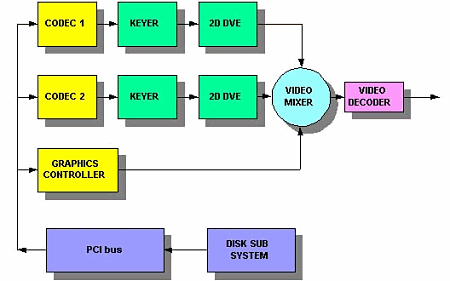 Operation of a traditional double-flow editing system A nonchangeable processing algorithm, impossibility of simultaneous operation with signals of different formats, operation with only two video layers are the worst drawbacks inherited from double-flow editing cards. Ideally, a modern digital system must be scalable, expandable and reprogrammable. All this requires a powerful video processor with flexible access to a sizeable and fast RAM. Such architecture is called Memory centric. 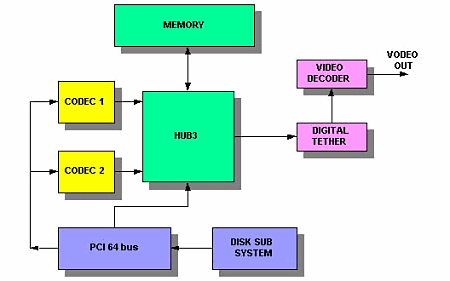 Operation of an editing system with the Memory Centric architecture This technology means conversion of any input signal into a digital array put into a local RAM. Then a video processor implements necessary conversions and also places the results into the RAM. When the operation is completed the output array again turns into a digital stream. The memory centric architecture has some advantages over a traditional one. First of all, it is combination of flexibility typical of program solutions and a speed of hardware acceleration. Besides, representation of a video stream as a numerical array makes possible to use any resolutions and to work simultaneously with any signal format. The first nonlinear editing card which used the memory centric architecture was multi-platform Targa 2000 from Truevision based on the HUB2 video processor. It was widely used in professional products both in PC and MAC systems. The next step was creation of HUB3 process which had 4 times better performance. HUB3 is a special video processor with large-scale integration and based on the 0.25-micron technology. According to the memory centric conception, the developers focused on a high-speed data exchange with RAM. A 128bit bus clocked at 100 MHz is used for this purpose. As a result, the peak bandwidth reaches 1.5 GBytes/s which allows transferring up to 75 flows of uncompressed 4:2:2 video standard CCIR 601 in a real time mode. All internal transformations are implemented as 4:4:4:4 or 4:2:2:4 with a quantization step of 8, 10 or 16bit for each components which provides very high quality of the output signal. The HUB3 has two independently programmable data processing blocks which can work in parallel. Each is capable to process up to 100 Mpixel/s which 8 times exceeds needs of video reproduction in a standard resolution in NTSC or PAL. The new processor is meant for modern efficient RAM chips such as SDRAM; it provides high performance and makes possible to use inexpensive standard memory chips. The HUB3 has a flexible architecture which can be changed on a program level. For example, it is possible to program the processor so that it may process frames with 16:9 side ratio or use progressive scanning without any hardware changes. 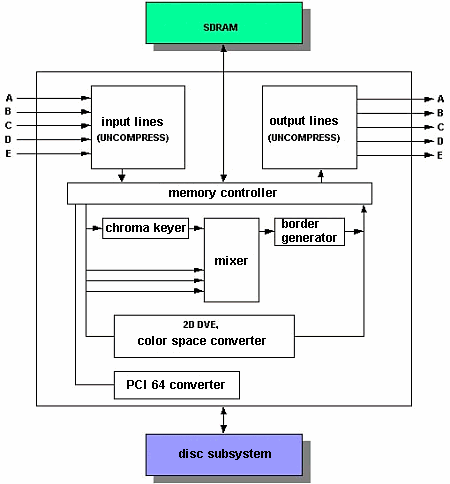 Block diagram of the HUB3 video processor Key characteristics of the Truevision HUB2 and HUB3 video processors
To make operation with an uncompressed signal satisfactory the developers used a lot of unique technical solutions the most of which are related with interfaces with external devices. Thus, a 32bit PCI bus is not efficient enough to transfer large streams of uncompressed video, that is why the HUB3 uses its own integrated 64bit DMA (Direct Memory Access) interface meant for a 33 MHz PCI64 industrial bus. The maximum data exchange rate between a graphics processor and a system memory or a disc subsystem is 200 MBytes/s. The chip has 5 integrated input ports and 5 output ones for external exchange of media data, each capable to work with one layer of uncompressed video and 8 channels of digital sound. All ports have their own internal DMA channels for fast and independent RAM access. As a result, video and audio encoding/decoding, mixing, keying and other processes are implemented in a real time mode using a local RAM. On the whole, unique capabilities of the HUB3 make possible to create editing soft hardware systems which wouldn't limit creativity and to open a new page in the history of video processing computer systems. Undoubtedly, a powerful video processor and a modern architecture are the base for a system to be built on but it is not enough. It is necessary to develop a board which would bring together all components, write drivers and additional software, test and then debug. That was what the engineers with Pinnacle Systems had to do when Truevision was purchased in 1999. It resulted in a better video editing desktop solution - Targa 3000. 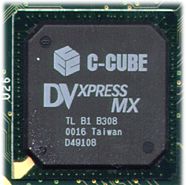 The Targa 3000 (T3K) is a full-sized PCI64 board with a DV port and a connector for external commutation boxes. The board has 128 MBytes RAM and two hardware DV25/MPEG2 C-Cube DVXpress codecs. 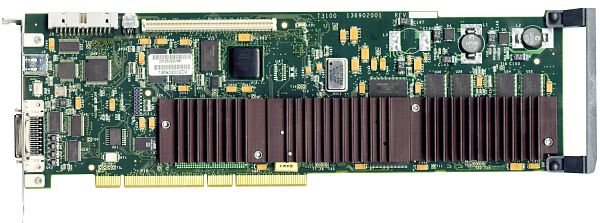 Targa3000 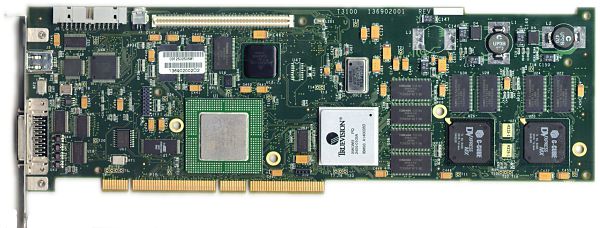 Targa3000 (the heatsink taken off) The Targa 3000 is able to reproduce up to three streams of uncompressed video and up to 5 graphics layers simultaneously in a real time mode. A user can set the number of layers to be reproduced without calculation depending on the tests and overall performance. In general, the card provides unique possibilities in reproduction of several video flows; one can use up to 16 layers with hardware acceleration and instant displaying of the results in course of the processing. Such scalable rendering technology considerably accelerates operation and makes it more demonstrative. None of the Targa3000's competitors has such capabilities. Apart from operation with an uncompressed signal in the YUVA and RGBA formats there are such compression types as DV25 and MPEG-2 (I-frames 2-50 Mbit/s). At the same time, it is possible to adjust key parameters of the MPEG flow and use materials in any of the above formats in the same project. However, it takes some more time to place clips of DV25 and MPEG-2 standards on the TimeLine as it is needed to convert them into that compression type which is set in the project's parameters. Like all modern video editing cards the T3K has several hundreds of 2D effects and filters which can be implemented in a real time mode, and the software includes FX Factory - a flexible mechanism which allows you to change various parameters and create your own effects. 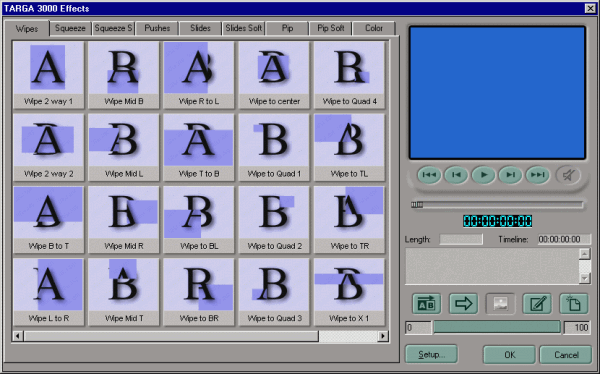 Working window of the FX Factory program module If you need to implement complicated 3D transitions you can use a program 3D effect-processor Hollywood FX Silver supplied with the card. Unfortunately, there is no a hardware 3D module. Taking into account that the Targa 3000 is the most up-to-date editing system of Pinnacle Systems, it can be considered a significant disadvantage. Apart from various 2D transitions and filters the Targa 3000 implements color correction, alpha, luma and chroma keying on any color component without changing shadows in a real time mode. One more peculiarity of the product is high-quality realization of slowed and accelerated reproduction. Thanks to the memory centric architecture and the new algorithm these operations do not require preliminary calculation. The Targa 3000 incorporates a lot of interesting ideas appeared within the last several years in the digital video processing sphere. And an I/O subsystem is not an exception. The development of the desktop systems for video editing brought in a problem of where to place external connectors on a PCI card. Operation with various digital and analog equipment requires 18 - 30 different connectors, while it is actually possible to place only 4-5 standard RCA or BNC connectors. The first solution was a passive analog interface, i.e. a long cable with a multicontact D-SUB plug on one end and a set of audio and video connectors on the other. Apart from inconvenience such bunch of cable produced a lot of noise. External analog boxes improved the situation as they had all necessary connectors on the front panel, however a thick interface cable with a great deal of shielded coaxial cables remained a problem. Active analog boxes (BreakoutBox, BoB) were a real breakthrough as they made possible to reduce the number of connection signal lines to a minimum. The main idea is that the BoB is an independent active device. All analog signals are converted in it into one format (most often, a component format for video and a symmetrical balanced format for audio) which is used for data transfer. The external unit has preliminary amplifiers but all ADCs are still placed on the PCI card, that is why noise and pickups caused by strong electromagnetic fields inside the system block remain a problem. Of course, the active analog interface much improved characteristics of the I/O system, but the only normal solution is a digital communication line. In this case an external Breakout Box acts as a DAC/ACD, and data are exchanged only in a digital form. The developers of the Targa 3000 went further and created a universal interface - Digital Tether - for both analog and digital devices. 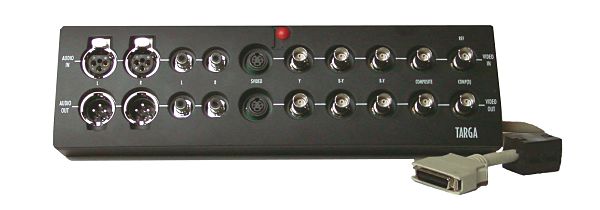 Analog commutation module with Digital Tether interface 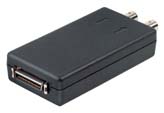 Digital commutation module (SDI) Digital Tether is a digital bidirectional interface between a PCI card and external Breakout Box. Audio, video and control data are transferred at the speed up to 1485 Mbit/s each way. The LVD (Lov Voltage Differential) standard which provides good noise immunity and low energy consumption is used to transfer data. All signal conversions are now implemented in the BoB far from a powerful source of electromagnetic fields (computer). The Digital Tether easily works both with PAL/NTSC (768x576) and HDTV standards, however, the Targa 3000 doesn't support the High Definition mode. In the SDTV mode at 27 MHz it is possible to transfer up to 2 video and 32 audio channels at the same time. All necessary information for initialization and management of the Breakout Box is transferred via the same signal lines which are used for media data and doesn't need a separate channel. The Targa3000 comes with one of the external modules - Targa Pro Digital or Targa Pro Analog. The analog BoB has a full set of component, composite and Y/C video connectors, and balanced and unbalanced inputs/outputs; the digital module operates with an SDI signal and it looks like a box with two BNC connectors. According to Pinnacle Systems, an analog/digital Breakout Box will also appear soon; it will make possible to work with any modern video equipment without unnecessary overcommutation. The Digital Tether management system provides automatic identification of a connected external module and allows replacing them without any preliminary preparations. However, it is recommended that you turn off the computer when you are going to change a commutation module. A block of automatic safety devices protects from overload or short circuit; they return into the initial state when the destructive effect ceases. Besides, a cable between the external box and the PCI card is much thinner and has a 36-pin connector of the mini Centronix type on its end. An external interface of the Targa 3000 is very interesting. Thanks to the modern technical solutions the developers were able to solve all major problems of the I/O system and made considerable step improving signal quality. The only drawback is impossibility to use an analog and a digital module simultaneously. The card has only one Digital Tether connector, that is why when changing a source signal one has to connect a respective commutation module. Besides, it is desired that it can be possible to install such module into a 19" bay. The Targa 3000 is a complex system of software ad hardware means. We have discussed its hardware part and now let's turn to its software which has quite decent disadvantages. The Targa 3000 can use only Adobe Premiere or Speed Razor from In-Sync as a video editor. I think the *edit from Discreet Logic suits better. Although the current versions 6.0 and 6.0+ do not support the T3K, the *edit 6.5 will reportedly get it. For a long time the T3K worked only with the Adobe Premiere 5.1, but now one can use the latest set of drivers of v1.5 meant for Windows 2000 and Adobe Premiere 6.0 or Speed Razor 2000x. Although the card appeared 1.5 years ago the software and drivers still have some significant drawbacks. For example, every time you start/stop reproduction from the Time Line there is a delay of several tens of frames. This bug makes editing difficult and hampers a team work of a producer and an editor. Besides, real requirements of modern television production were not accounted for when the interface was developing. For example, when the material is captured and output onto the tape it is impossible to change parameters of audio and video signals on the fly, such control means as a program vectroscope and a wave form monitor are lacking. It is necessary to open the general FX Factory control panel each time you need to choose and adjust any filter or effect. This function takes quite a lot of time even on a high-efficient computer. Apart from downsides the software has some advantages. For example, the card comes with DV 25 and YUV program codecs, a speedy MPEG-2 coder working in a real time mode and a plug-in for the Adobe After Effects which can display an image directly on a TV screen. Besides, there is a great packet for complicated editing, compositoring and rotoscoping - Commotion Pro, Title Deko and some other interesting and useful applications. The Targa 3000 needs a carefully chosen computer platform. The simplest way is to use a finished certified platform from one of leaders in the computer industry, however, there are some downsides. First of all, it is a high price. Besides, there is an incompatibility problem of finished work stations and different equipment. For example, certified model SP750 from Compaq doesn't work with SCSI controllers ATTO UL3D, UL2D and QLOGIC QLA2160. If a user is going to assemble a system himself there are two ways the developers suggest. The first is meant for operation only with a compressed video signal (DV25, MPEG-2) and doesn't demand much of a computer platform. The maximum speed of one flow doesn't exceed 6.25 MBytes/s, and a 32bit PCI bus is enough for operation. Frankly speaking, such an expensive system for editing in the DV format doesn't seem to be a rational decision, especially considering that there are solutions which are able to work with 4 DV video layers simultaneously (for example, Canopus DV Rex RT). That is why a configuration designed for an uncompressed signal is of greater interest. Anyway it is recommended that you have a mainboard on i440BX, i815, i840 or Serverworks chipsets. Besides, you need 256 or 512 MBytes of RAM and a high-performance disc subsystem with a SCSI interface. For operation with DV or MPEG flows it is sufficient to have two speedy hard drives combined into RAID 0 (stripe), 4 drives are required for reproduction of two flows of YUV uncompressed video (4:2:2, 20 MBytes/s), and for operation with 3 layers it is necessary to combine 8 drives in an array. If you need to reproduce the maximum number of streams simultaneously you should have a dual-channel PCI64 SCSI controller with separation of drives into two groups with 4 on each channel. It should be noted that if you use a system with a PCI64 bus it is very important to use only free 64bit PCI slots. Installation of one more PCI 32 card often causes delays in operation of the editing program. The experience shows that you don't have to get an expensive RAID based on SCSI drives for reproduction of three streams, and a disc array like Medea Video RAID RTX will be enough. Although this video RAID is built on IDE discs which are considered slower than SCSI ones the steady speed of a data flow is 80 MBytes/s. The Medea uses its own high-performance SCSI-IDE controller and the speediest modern hard drives from top manufacturers. All drives are carefully selected and prepared. Today an IDE drive suits even high-level video editing as the most important parameter - a linear read speed - is better, for example, of the IBM Deskstar 75GXP than of the professional SCSI drive Ultrastar 36LZX. A SCSI controller also has a great effect on a performance of the disc subsystem. The devices which provide hardware realization of a RAID array are preferable. For example, a dual-channel UL3D controller from ATTO provides a considerable speed reserve as compared with popular Adaptec 39160. A more expensive and efficient controller will help if a disc subsystem is just a little below the required level. Although a processor load doesn't exceed 10-12% when several streams are reproduced it is still recommended that you use modern and high-efficient CPUs as the system has a lot of other tough tasks of video processing. As the Targa 3000 works under Windows NT 4.0 and Windows 2000 it's better to use dual-processor configurations. Now a little on a video system. First of all, it is required that a video card display an overlay window very well. Unfortunately, far not all modern cards are able to do it. Video cards from ATI and Matrox suit best for video editing, especially Matrox G400/G450/G550 of the Dual head version. Nvidia based cards are also a good choice, but you should carefully choose drivers so that the overlay can work well. Remember if you use a mainboard on Serverworks, for example, Tyan S1867 Thunder 2500, you have to use a PCI video adapter. In this case an AGP port doesn't allow displaying an overlay image whatever AGP video card is used. So, the requirements for a computer platform are rather tough. The Targa 3000 developers carefully tested and certified the components and you can look at the detailed results at the site of Pinnacle Systems. In closing I'd like to speak on possible variants of using the most powerful modern editing system based on the Targa 3000. The NLO systems are successfully fighting traditional linear systems and hybrid editing systems thanks to developing technologies, increasing PC performance and reducing prices of discs. A computer system has its own advantages and disadvantages but it's unquestionable that such solution allows adjusting to a certain video production process, as well as helps to save money. Today even the most powerful work station based on the Targa 3000 is several times cheaper than a multioperator editing system with tape recorders, mixers, controllers and effectors, though they are almost on the same level: the most of filters, effects and transitions can be done by a desktop system in a real time mode. Thus, the T3K system can be used as a system of prompt and complicated editing by big studios and television channels if there is not enough time. 4:4:4:4 color representation and a possibility to work with an uncompressed signal makes possible to use the Targa3000 for multilayer editing and compositoring. One more application is a joint operation of several video machines on a network. By the way, you can use in pairs not only the same work stations but also much less decent as far as system requirements of DV500+ are concerned. It is especially interesting as files recorded in the DV25 standard are fully compatible. And now let me mark out main merits and downsides of the Targa 3000 based system: Highs
Lows
The T3K is really a revolutionary product which
incorporates a great deal of interesting technical and technological
ideas, yet it has some bugs to be eliminated. I think soon good
few developers of software and hardware products will be guided
by the Targa 3000 as a new standard in the video production sphere.
Write a comment below. No registration needed!
|
Platform · Video · Multimedia · Mobile · Other || About us & Privacy policy · Twitter · Facebook Copyright © Byrds Research & Publishing, Ltd., 1997–2011. All rights reserved. |